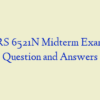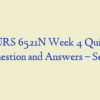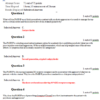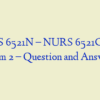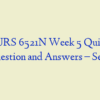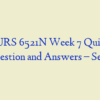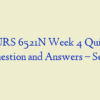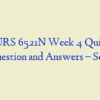Description
NURS 6521N Week 1 Quiz
- Tylenol 325 mg/tablet, patient needs 650 mg; how many tables should patient take?
- During a clinic visit, a patient complains of having frequent muscle cramps in her legs. The nurse’s assessment reveals that the patient has been taking over-the-counter laxatives for the past 7 years. The nurse informed the patient that prolonged use of laxatives
- A 60-year-old African-American man lives with a number of chronic health problems. Genetic factors are likely to influence his etiology and/or treatment of
- In response to a patient’s nausea, the nurse has mixed a dose of an antiemetic with 50 mL of sterile normal saline and will administer the dose by IV piggyback. What is the rationale for the use of IV piggyback?
- In light of her recent high blood pressure readings, a patient has been started on a thiazide diuretic and metoprolol (Lopressor), which is a beta-adrenergic blocker. What is the most likely rationale for using two medications to address the patient’s hypertension?
- A patient with a variety of chronic health problems is being seen by her nurse practitioner, who is currently reviewing the patient’s medication regimen. Which of the patient’s medications should prompt the nurse to teach her to avoid drinking grapefruit juice?
- A patient has been prescribed several drugs and fluids to be given intravenously. Before the nurse starts the intravenous administration, a priority assessment of the patient will be to note the
- A patient has been prescribed 1 mg lorazepam (Ativan) sublingual prior to the scheduled insertion of a peripherally inserted central (PIC) line. How should the nurse direct the patient when administering this medication?
- A nurse is instructing a patient concerning a newly prescribed drug.
- Which of the following should be included to help improve patient compliance and safety?
- A mother brings her 4-year-old child, who is vomiting and has a temperature of 103°F into the emergency department (ED). The ED physician orders acetaminophen (Tylenol) for the fever. The best form of Tylenol to give the child, considering her presentation, would be
- On the 1 a.m. rounds, the nurse finds a patient awake and frustrated that she cannot go to sleep. The nurse administers an ordered hypnotic to help the patient sleep. Two hours later, the nurse finds the patient out of bed, full of energy and cleaning her room. The nurse evaluates the patient’s response to the hypnotic as
- A patient has been receiving regular doses of an agonist for 2 weeks. Which of the following should the nurse anticipate?
- In which of the following patients would a nurse expect to experience alterations in drug metabolism?
- A nurse is caring for a patient who has recently moved from Vermont to south Florida. The patient has been on the same antihypertensive drug for 6 years and has had stable blood pressures and no adverse effects. Since her move, however, she reports “dizzy spells and weakness” and feels that the drug is no longer effective. The nurse suspects that the change in the effectiveness of the drug is related to
- 30 ml = _______________tbsp
- Talwin given in combination with Vistaril diminishes the adverse effects of nausea caused by the Talwin. This drug interaction affecting the pharmacodynamics of the Talwin is
- A nurse who is responsible for administering medications should understand that the goals of the MedWatch program are to (Select all that apply.)
- A patient who has ongoing pain issues has been prescribed meperidine (Demerol) IM.
- How should the nurse best administer this medication?
- The nurse is caring for a patient receiving an aminoglycoside (antibiotic) that can be nephrotoxic. Which of the following will alert the nurse that the patient may be experiencing nephrotoxicity?
- For which of the following patients would a nasogastric tube most likely be considered to aid in the administration of medications?
- A patient has been prescribed an oral drug that is known to have a high first-pass effect. Which of the following measures has the potential to increase the amount of the free drug that is available to body cells?
- A patient has a blood serum drug level of 50 units/mL. The drug’s half-life is 1 hour. If concentrations above 25 units/mL are toxic and no more of the drug is given, how long will it take for the blood level to reach the nontoxic range?
- A patient with a recent diagnosis of acute renal failure has a long-standing seizure disorder which has been successfully controlled for several years with antiseizure medications. The nurse should recognize that the patient’s compromised renal function will likely
- A nurse is caring for a patient who has had part of her small intestine removed due to cancer. She has also now developed hypertension and has been prescribed a new medication to decrease her blood pressure. While planning the patient’s care, the nurse should consider a possible alteration in which of the following aspects of pharmacokinetics?
- A nurse is caring for a postsurgical patient who has small tortuous veins and had a difficult IV insertion.
- The patient is now receiving IV medications on a regular basis.
- What is the best nursing intervention to minimize the adverse effects of this drug therapy?
- An older adult who lives in a long-term care facility has recently begun taking losartan (Cozaar) for the treatment of hypertension. The nurse who provides care for this resident should recognize that this change in the resident’s medication regimen make create a risk for
- A 79-year-old woman has been admitted to the hospital with a gastrointestinal bleed. She is currently receiving a transfusion of packed red blood cells as well as an infusion of pantoprazole (Protonix), a proton-pump inhibitor, to help stop her bleeding. What care setting is most appropriate for this patient?
- A 77-year-old man with a long history of absence seizures has been treated with ethosuximide for many years. The man is now in the process of moving to a long-term care facility and a nurse is creating a plan of care. The nurse understands the potential adverse effects of this drug and would consequently prioritize which of the following nursing diagnoses?
- A nurse who is working with an older adult patient who takes eight medications a day wants to promote medication adherence. Which of the following nursing interventions would best promote medication adherence?
- A 79-year-old patient in a long-term care facility is to receive an intravenous fat emulsion.
- Which of the following lab values would be a priority for the nurse to assess before administration?
- Medication reconciliation of an 82-year-old man who has recently moved to a long-term care facility reveals that the man takes 1 to 2 mg of lorazepam bid prn. The nurse should recognize what consequence of this aspect of the resident’s drug regimen?
- A 66-year-old woman has a complex medical history that includes poorly-controlled type 1 diabetes, renal failure as a result of diabetic nephropathy and chronic heart failure (CHF). Her care provider has recently added spironolactone (Aldactone) to the woman’s medication regimen. The nurse should consequently assess for signs and symptoms of
- Mrs. Houston is a 78-year-old woman who resides in an assisted living facility. Her doctor prescribed digoxin at her last visit to the clinic and she has approached the nurse who makes regular visits to the assisted-living facility about this new drug. What teaching point should the nurse emphasize to Mrs. Houston?
- Mr. Penny, age 67, was diagnosed with chronic angina several months ago and has been unable to experience adequate relief of his symptoms. As a result, his physician has prescribed ranolazine (Ranexa). Which of the following statements is true regarding the use of ranolazine for the treatment of this patient’s angina?
- A 90-year-old frail, elderly woman has arrived at the emergency department with a broken hip and in acute respiratory distress. Succinylcholine will be used because of the need for rapid endotracheal intubation, and then the woman will be sent to surgery. Due to the woman’s frail condition, she is at risk for skin breakdown. Which of the following nursing diagnoses would be most appropriate?
- A nurse is caring for an 81-year-old patient in a long-term care facility who takes nine different medications each day.
- The patient has a recent diagnosis of seizure disorder and has begun treatment with phenytoin (Dilantin), a highly protein-bound drug. After 1 month of Dilantin therapy, the patient is still extremely drowsy and sluggish. The nurse determines that the prolonged adverse effect is likely due to
- A 70-year-old woman is starting on an acidic drug. The nurse is aware that food and nutrient intake can affect drug excretion by changing the urinary pH. About which of the following will the nurse question the patient concerning her diet?
- A 72-year-old man with pain issues is being given a drug by the intramuscular route. His serum blood level concentrations have been erratic. The nurse suspects that this may be due to
- Mr. Nguyen, age 71, will soon be discharged home from the hospital after a successful coronary artery bypass graft (CABG). During patient education about his drug regimen, Mr. Nguyen’s nurse should prioritize teach about
- A nurse is conducting an assessment of a patient who has recently had several changes made to her drug regimen. What assessment question most directly addresses the safety implications of the patient’s drug regimen?
- So, check out our latest Tutorials and Courses on BUSI 435.




